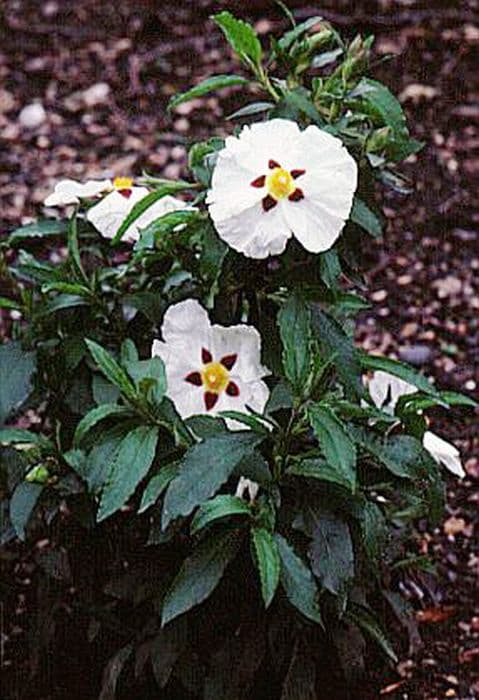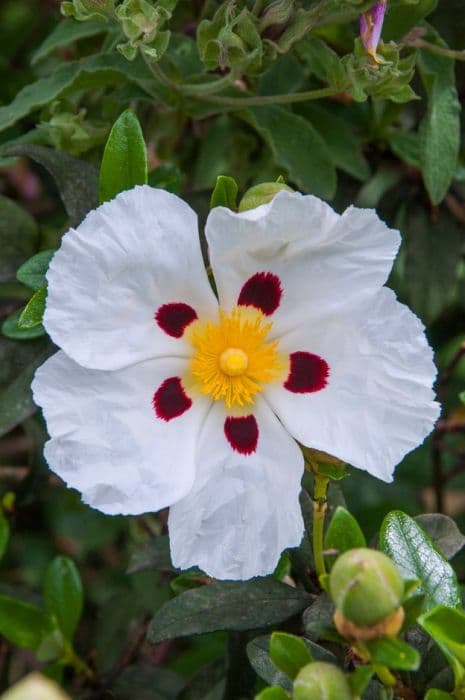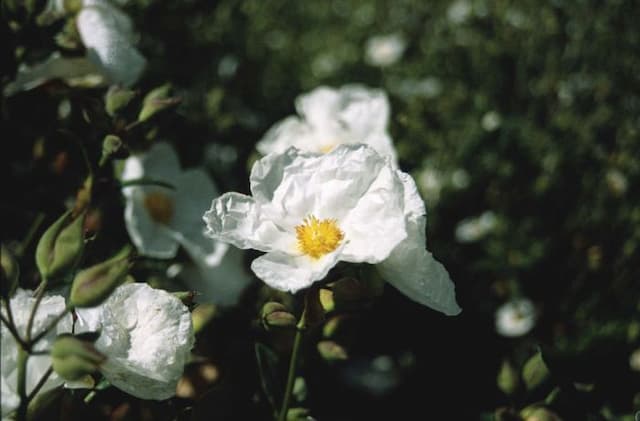Rock Rose Cistus × obtusifolius 'Thrive'

ABOUT
The plant known as Rockrose 'Thrive' is a visually striking specimen with a lush, bush-like appearance. Its foliage consists of a dense, evergreen mass of leaves, which are typically broad and have a slightly wavy margin, giving them a rich and textured look. The leaves themselves exude a glossy finish, contributing to the plant's vibrant presentation. Flowering is a prominent feature of the Rockrose 'Thrive,' with blooms that captivate onlookers. The flowers are large and showy, boasting a palette of soft to bright pink shades that often feature a subtle gradient in color. In the center of each bloom, a cluster of prominent golden-yellow stamens stands out, providing a striking contrast against the petals and attracting a host of pollinators. The overall form of the Rockrose 'Thrive' is rounded and fairly compact, creating an appearance that is both neat and robust. It offers a substantial coverage of space, contributing a full-bodied presence in the garden setting. This plant radiates a Mediterranean charm, fitting perfectly into a variety of landscape designs that could benefit from its ornamental qualities and resilience against dry conditions.
About this plant
 Names
NamesFamily
Cistaceae.
Synonyms
No common names available.
Common names
Cistus × obtusifolius 'Thrive'.
 Toxicity
ToxicityTo humans
There is no widely available information suggesting that the Rockrose (Cistus × obtusifolius 'Thrive') is toxic to humans. While it is always advisable to exercise caution and avoid ingesting plants not meant for consumption, there have been no significant reports of toxicity or symptoms associated with the ingestion of parts of this plant as of my last update.
To pets
Similarly, there is limited information regarding the toxicity of the Rockrose (Cistus × obtusifolius 'Thrive') to pets. It is generally not listed among plants that are known to be hazardous to pets. However, as with any non-food plant, it is prudent to prevent pets from ingesting this plant to avoid the possibility of an unpredictable reaction or gastrointestinal upset.
 Characteristics
CharacteristicsLife cycle
Perennials
Foliage type
Evergreen
Color of leaves
Green
Flower color
White
Height
3 feet 3 inches (1 m)
Spread
5 feet 5 inches (1.65 m)
Plant type
Shrub
Hardiness zones
8
Native area
Mediterranean
Benefits
 General Benefits
General Benefits- Drought Tolerance: Cistus × obtusifolius 'Thrive' is highly resistant to dry conditions, reducing the need for frequent watering once established.
- Low Maintenance: The plant requires minimal upkeep, as it does not need regular pruning or special treatments.
- Rapid Growth: It is known for its quick growth, providing fast coverage or filling in garden spaces efficiently.
- Attracts Pollinators: The flowers attract bees and butterflies, which is beneficial for pollination of gardens and ecosystems.
- Deer Resistance: The plant is not preferred by deer, making it suitable for gardens in areas where deer browsing is a problem.
- Disease Resistance: Cistus × obtusifolius 'Thrive' is generally resistant to common plant diseases, ensuring a healthy and long-lasting garden display.
- Soil Versatility: It can thrive in a wide range of soil types, including poor soils, reducing the need for soil amendments or fertilizers.
- Landscape Use: The plant's structure and vibrant blooms make it an ideal choice for Mediterranean-style gardens, rock gardens, borders, or as ground cover.
- Evergreen Foliage: It retains its foliage throughout the year, providing ongoing visual interest even when not in bloom.
- Tolerance to Wind and Salt: This plant can withstand coastal conditions, making it suitable for seaside planting.
 Medical Properties
Medical PropertiesThis plant is not used for medical purposes.
 Air-purifying Qualities
Air-purifying QualitiesThis plant is not specifically known for air purifying qualities.
 Other Uses
Other Uses- As a natural insect repellant: The aromatic oils of Cistus 'Thrive' may deter certain insects, making it a suitable companion plant in gardens to keep pests at bay.
- For essential oil production: The plant can be used in the production of essential oils which might be used in perfumery and aromatherapy.
- In eco-friendly landscaping: Cistus 'Thrive' is drought-resistant and therefore suitable for xeriscaping, requiring less water and reducing reliance on irrigation.
- As a firebreak plant: Its ability to resist ignition can make Cistus 'Thrive' a strategic choice for planting in fire-prone areas to help slow the spread of wildfires.
- For erosion control: The plant’s roots help to stabilize soil on slopes and prevent erosion, particularly in Mediterranean climates.
- As a dye plant: Historically, some Cistus species have been used to obtain dyes for textiles, and Cistus 'Thrive' may also have this potential.
- In artistic crafts: Dried stems and flowers can be used for creating floral arrangements, potpourri, or in craft projects.
- In culinary uses: While not commonly ingested, some Cistus species have been used as flavoring agents, so 'Thrive' could theoretically find its way into experimental gastronomy.
- Outdoor noise reduction: Dense plantings of Cistus 'Thrive' can help to reduce sound transmission, acting as a natural sound barrier in gardens and landscapes.
- As ornamental topiary: With proper pruning, 'Thrive' can be shaped into various forms for decorative purposes in formal gardens.
Interesting Facts
 Feng Shui
Feng ShuiThe Rockrose is not used in Feng Shui practice.
 Zodiac Sign Compitability
Zodiac Sign CompitabilityThe Rockrose is not used in astrology practice.
 Plant Symbolism
Plant Symbolism- Resilience: The rockrose is known for its hardy nature, capable of thriving in poor soils and dry conditions, symbolizing the ability to endure and prosper despite challenges.
- Beauty: With its showy flowers, the rockrose symbolizes beauty and the appreciation of aesthetics, representing the idea that beauty can flourish in harsh surroundings.
- Healing: Historically, various species of Cistus have been used in herbal medicine, and the rockrose can symbolize healing and therapeutic properties.
- Renewal: The rockrose's ability to regenerate after fires through its seed bank is symbolic of renewal, rebirth, and the capacity to start anew after difficulties.
- Purity: The bright and often white blooms of the rockrose are associated with purity and innocence, conveying a sense of clarity and simplicity.
 Water
WaterRockrose 'Thrive' prefers a well-draining soil and should be watered deeply yet infrequently to encourage a strong root system. In the first growing season, water the plant about once a week with approximately 1-2 gallons, depending on soil and weather conditions, to establish it. Once established, the Rockrose is drought-tolerant and can typically survive with natural rainfall, though a monthly deep watering during prolonged dry spells can be beneficial. Always check the top few inches of soil for dryness before watering. Overwatering or poor drainage can lead to root rot, so ensure that the plant is not left in soggy soil.
 Light
LightRockrose 'Thrive' thrives in full sun conditions, needing at least six hours of direct sunlight per day to perform best. Plant it in a spot where it can receive unfiltered, direct light throughout the day. Dappled light or partial shade may cause the plant to grow less vigorously and produce fewer flowers.
 Temperature
TemperatureRockrose 'Thrive' can endure a wide range of temperatures but prefers a warm climate. It can tolerate minimum temperatures down to about 20 degrees Fahrenheit but may suffer damage if exposed to prolonged frosts. The ideal temperature range for Rockrose 'Thrive' is between 60 and 80 degrees Fahrenheit, where it can grow and flower optimally. Ensure it's protected or covered if a sudden cold snap is forecasted.
 Pruning
PruningRockrose 'Thrive' benefits from pruning to maintain its shape and promote vigorous growth. Prune the plant lightly after it blooms to remove spent flowers and encourage a second bloom. Pruning can be done annually or every other year, depending on the growth rate and desired size. The best time for pruning is in late spring or early summer, once the main flowering period has finished.
 Cleaning
CleaningAs needed
 Soil
SoilThe best soil mix for Rock Rose (Cistus × obtusifolius 'Thrive') is well-draining with a composition of loam, sand, and a bit of organic matter, ensuring good aeration and drainage. The preferred soil pH for Rock Rose should be slightly acidic to neutral, ranging between 6.0 and 7.5. Adaptable to various soil types, ensuring proper drainage is the key to its healthy growth.
 Repotting
RepottingRock Rose does not require frequent repotting; it should be repotted every 2 to 3 years, especially if it's growing in a pot and has outgrown its current one. It is best to repot in spring before new growth begins.
 Humidity & Misting
Humidity & MistingRock Rose thrives in the typical humidity levels found outdoors and does not require high humidity. It is relatively drought-tolerant and can handle dry air conditions without needing to increase humidity artificially.
 Suitable locations
Suitable locationsIndoor
Place Rock Rose in bright light, limit watering.
Outdoor
Sunny spot, well-drained soil, shield from cold winds.
Hardiness zone
8-11 USDA
 Life cycle
Life cycleCistus × obtusifolius 'Thrive', commonly known as a Rockrose hybrid, begins its life cycle with seed germination, which requires well-drained soil and a sunny location. Once the seedling emerges, it enters a vegetative growth phase, developing a woody base and evergreen leaves. As the plant matures, it goes through a flowering stage, usually in late spring to early summer, where it produces showy, rose-like flowers that attract pollinators. Following pollination, the Rockrose forms seed capsules if the conditions allow for sexual reproduction, which then disperse to start the cycle anew. The plant also expands through vegetative means as it becomes larger each year, with a life span of several years. Seasonal conditions trigger periods of dormancy, particularly in colder regions, where the Rockrose may shed some leaves and reduce growth until favorable conditions return.
 Propogation
PropogationPropogation time
Spring-Early Summer
Propogation: The most popular method for propagating the Rock Rose 'Thrive' is through semi-hardwood cuttings. The ideal time to take these cuttings is during late summer when the new growth has begun to harden. To start, you would cut a 4 to 6 inch (about 10 to 15 cm) length of stem, making sure that it includes several leaves and at least one node. These cuttings should then be stripped of their lower leaves, dipped in rooting hormone, and inserted into a mixture of perlite and peat moss. The cuttings need to be kept moist and in a well-lit area, but out of direct sunlight until roots have developed, which usually takes several weeks. After rooting, they can be transplanted into individual pots and grown on until they are robust enough to plant outdoors.









